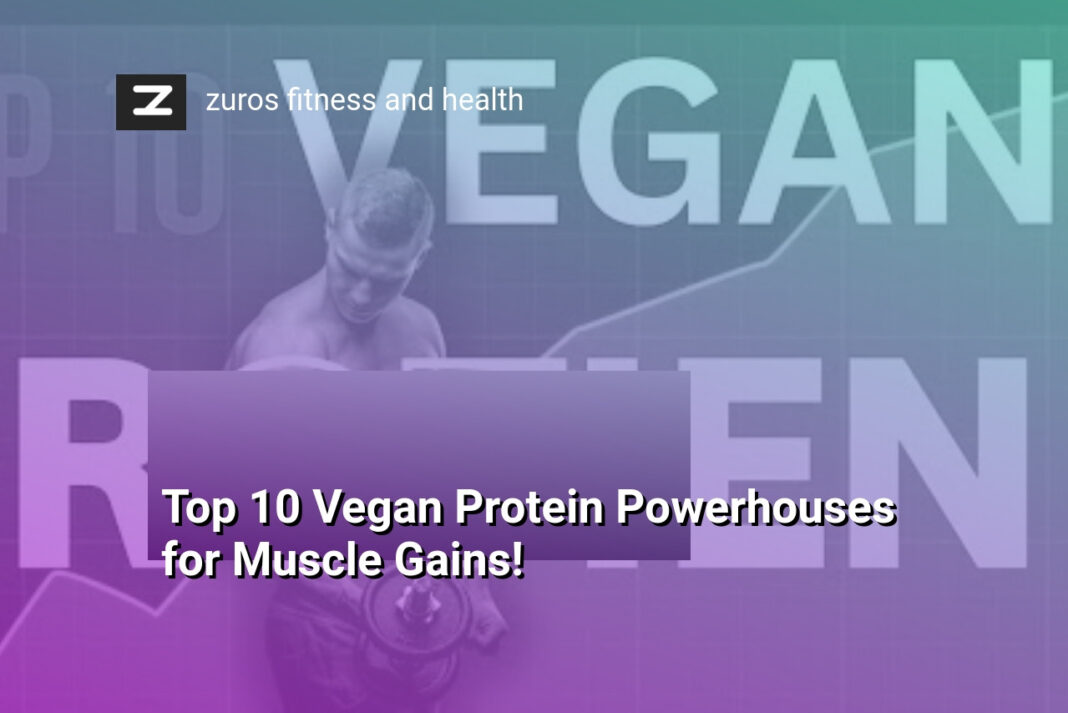The Bottom Line:
Here is a summary of the main points in the specified format:
- I’m excited to share my top 10 vegan protein sources that are perfect for building muscle and keeping you energized, whether you’re a committed vegan or just curious about plant-based options.
- Legumes like lentils and chickpeas are affordable, versatile, and packed with protein, fiber, and essential nutrients, making them a must-have in any vegan kitchen.
- Quinoa, a gluten-free ancient grain, is a complete protein source, while almonds offer a satisfying crunch along with healthy fats and vitamin E.
- Nutrient-dense superfoods like chia seeds, hemp seeds, and spirulina are easy to incorporate into your diet and provide a wide array of health benefits.
- For those seeking meat alternatives, pea protein powder, tempeh, and seitan are excellent options that are high in protein and can be used in a variety of delicious recipes.
Lentils: Protein-Packed Legumes for a Hearty Meal
Nutritional Powerhouse: Lentils
Lentils are a true nutritional powerhouse, offering an impressive array of essential nutrients in each serving. These tiny legumes are packed with protein, providing a substantial 18 grams per cooked cup, making them an excellent choice for vegans and vegetarians looking to support muscle growth and maintenance. Lentils are also an excellent source of complex carbohydrates and dietary fiber, which help to keep you feeling full and satisfied for longer periods, aiding in weight management and digestive health.
In addition to their protein and fiber content, lentils are rich in various vitamins and minerals. They are particularly high in folate, a B-vitamin essential for proper cell growth and development, as well as iron, which plays a crucial role in oxygen transport throughout the body. Lentils also contain significant amounts of potassium, magnesium, and zinc, all of which contribute to overall health and well-being.
Versatile and Affordable
One of the greatest advantages of incorporating lentils into your diet is their versatility and affordability. These humble legumes come in a variety of colors and sizes, each with its own unique flavor profile and texture. From the earthy and robust brown lentils to the delicate and quick-cooking red lentils, there is a lentil to suit every taste preference and culinary application.
Lentils are incredibly easy to prepare and can be incorporated into a wide range of dishes. They can be simmered into a comforting and hearty soup, tossed into a colorful and nutrient-dense salad, or even mashed and formed into savory veggie burgers. Their ability to absorb flavors from aromatic spices and herbs makes them a perfect canvas for creating delicious and satisfying meals.
Sustainable and Eco-Friendly
Not only are lentils a nutritional and culinary asset, but they also offer significant environmental benefits. As a member of the legume family, lentils have the unique ability to fix nitrogen in the soil, reducing the need for synthetic fertilizers and improving soil health. This makes them an eco-friendly and sustainable crop, contributing to the overall well-being of our planet.
Furthermore, lentils have a relatively low carbon footprint compared to animal-based protein sources, making them an excellent choice for those looking to reduce their environmental impact. By incorporating more lentils and other plant-based proteins into our diets, we can collectively work towards a more sustainable and compassionate food system.
Chickpeas: Versatile and Nutritious Powerhouses
Nutritional Profile and Health Benefits
Chickpeas, also known as garbanzo beans, are a nutrient-dense legume that offers a wide array of health benefits. They are an excellent source of plant-based protein, providing about 14.5 grams per cup, making them an ideal choice for vegans and vegetarians looking to support muscle growth and maintenance. In addition to protein, chickpeas are rich in complex carbohydrates, fiber, vitamins, and minerals, such as folate, iron, magnesium, and potassium. The high fiber content in chickpeas promotes digestive health, helps regulate blood sugar levels, and keeps you feeling full and satisfied for longer periods.
Moreover, chickpeas contain several antioxidants and anti-inflammatory compounds, such as polyphenols and flavonoids, which help combat oxidative stress and reduce the risk of chronic diseases like heart disease, diabetes, and certain cancers. The iron content in chickpeas is particularly beneficial for vegans, as it contributes to the production of hemoglobin and the prevention of iron-deficiency anemia.
Culinary Versatility and Preparation Methods
One of the greatest advantages of chickpeas is their incredible versatility in the kitchen. They can be easily incorporated into a wide range of dishes, from savory to sweet, and can be prepared in numerous ways to suit various taste preferences. Chickpeas can be enjoyed whole, mashed, or blended, making them a perfect ingredient for salads, soups, stews, curries, and even baked goods.
Roasting chickpeas is a popular method that results in a crunchy, savory snack that can be seasoned with various spices and herbs. Hummus, a classic Middle Eastern dip made from blended chickpeas, tahini, lemon juice, and garlic, is a delicious and healthy spread that pairs well with vegetables, pita bread, or crackers. Chickpea flour, made from ground dried chickpeas, is a gluten-free alternative to wheat flour and can be used to make flatbreads, fritters, or as a thickener for soups and sauces.
Incorporating Chickpeas into Your Diet
Incorporating chickpeas into your diet is a simple and effective way to boost your protein intake and support muscle growth. Start by adding them to your salads for an extra protein punch, or use them as a base for hearty, plant-based soups and stews. Replace meat in your favorite recipes with chickpeas, such as in tacos, burritos, or pasta dishes, for a satisfying and nutritious meal.
Experiment with different flavor combinations and spices to keep your chickpea dishes exciting and diverse. For a quick and easy snack, toss canned chickpeas with olive oil, salt, and your favorite seasonings, then roast them in the oven until crispy. You can also make your own hummus at home by blending chickpeas with tahini, lemon juice, garlic, and olive oil, and enjoy it as a dip or spread.
By incorporating chickpeas into your vegan diet, you’ll not only support your muscle growth goals but also enjoy the numerous health benefits that these nutritious legumes have to offer.
Quinoa: Complete Protein for Gluten-Free Diets
A Gluten-Free Superfood
Quinoa, often referred to as an ancient grain, is a nutrient-dense superfood that has gained popularity in recent years, especially among those following gluten-free diets. Unlike wheat, barley, and rye, quinoa is naturally gluten-free, making it an excellent choice for individuals with celiac disease or gluten sensitivity. This versatile pseudocereal is not only easy to digest but also provides a wide array of essential nutrients, including protein, fiber, vitamins, and minerals.
The Perfect Plant-Based Protein
One of the most remarkable features of quinoa is its protein content. Unlike most plant-based proteins, quinoa is a complete protein, meaning it contains all nine essential amino acids that the human body cannot produce on its own. This makes quinoa an ideal protein source for vegans and vegetarians who may struggle to obtain complete proteins from their diet. Just one cup of cooked quinoa provides approximately 8 grams of high-quality protein, making it a fantastic addition to any meal or snack.
Versatile and Easy to Prepare
Quinoa’s versatility in the kitchen is another reason why it has become a staple in many gluten-free and vegan diets. Its mild, nutty flavor and fluffy texture make it a perfect substitute for rice, pasta, or other grains in a variety of dishes. You can use quinoa as a base for salads, stir-fries, and casseroles, or even as a breakfast porridge topped with fresh fruits and nuts. Cooking quinoa is simple and quick, requiring just 15-20 minutes of simmering in water or broth until the grains become tender and translucent.
Incorporating quinoa into your diet is an excellent way to ensure you’re getting the protein and nutrients your body needs to support optimal muscle growth and overall health, all while enjoying a delicious and gluten-free superfood.
Almonds and Chia Seeds: Tiny Nutritional Giants
Almonds: Nutrient-Dense Snacking Superstars
Almonds are not only a delicious and satisfying snack, but they also pack a powerful nutritional punch. These small, versatile nuts are rich in plant-based protein, making them an excellent choice for vegans looking to support muscle growth and maintenance. A single ounce of almonds contains approximately 6 grams of protein, along with a wealth of other essential nutrients like healthy fats, vitamin E, magnesium, and fiber.
The healthy fats found in almonds, particularly monounsaturated and polyunsaturated fats, are beneficial for heart health and can help reduce inflammation in the body. Vitamin E, a potent antioxidant, helps protect cells from oxidative stress and supports immune function. Magnesium, another key nutrient found in almonds, plays a crucial role in energy production, muscle and nerve function, and bone health.
Almonds are incredibly versatile and can be easily incorporated into a variety of dishes. Enjoy them as a standalone snack, chop them up and sprinkle over oatmeal or yogurt, or use almond butter as a spread on whole-grain toast or as a dip for fresh fruits and vegetables. You can also use almond flour as a gluten-free alternative in baking recipes, adding a boost of protein and nutty flavor to your favorite treats.
Chia Seeds: Small but Mighty Nutritional Powerhouses
Don’t let their tiny size fool you – chia seeds are a force to be reckoned with when it comes to nutrition. These ancient seeds, native to Mexico and Guatemala, have gained popularity in recent years due to their impressive nutrient profile. Just two tablespoons of chia seeds contain approximately 4 grams of protein, 11 grams of fiber, and 5 grams of omega-3 fatty acids, making them a true superfood for vegans and health enthusiasts alike.
Chia seeds are also an excellent source of calcium, phosphorus, and magnesium, all of which are essential for maintaining strong bones and teeth. The high fiber content in chia seeds promotes digestive health, helps regulate blood sugar levels, and keeps you feeling full and satisfied for longer periods.
One of the unique properties of chia seeds is their ability to absorb liquid and form a gel-like consistency, making them an ideal ingredient for healthy puddings, smoothies, and jams. To make a basic chia pudding, simply mix 1/4 cup of chia seeds with 1 cup of your favorite plant-based milk, add a sweetener of your choice, and let it sit in the refrigerator for a few hours or overnight. The result is a creamy, nutritious pudding that can be customized with various fruits, nuts, and spices to suit your taste preferences.
Spirulina, Pea Protein, Tempeh, and Seitan: Unique Vegan Protein Options
Spirulina: A Nutritional Powerhouse
Spirulina, a blue-green algae, is a true nutritional powerhouse packed with protein, vitamins, and minerals. This superfood is an excellent way to add a boost of nutrients to your vegan diet. Spirulina is easily found in powder form, making it convenient to add to smoothies, juices, or even energy balls for an extra splash of health. Just a small amount of spirulina can significantly enhance the nutritional value of your meals.
Pea Protein and Tempeh: Complete Proteins for Vegans
Pea protein powder and tempeh are two fantastic sources of complete protein for vegans. Pea protein is easily digestible and has a neutral flavor, making it perfect for adding to smoothies or shakes. It’s a convenient way to ensure you’re getting enough protein in your diet. Tempeh, on the other hand, is a fermented soybean product with a firm texture and nutty flavor. It’s not only high in protein but also a good source of fiber and probiotics. Tempeh can be marinated and grilled, crumbled into stir-fries, or used as a meat alternative in sandwiches.
Seitan: The Wheat-Based Meat Alternative
Seitan, a wheat gluten product, is another unique vegan protein option. It has a meaty texture and can be seasoned and cooked in various ways, making it a popular choice for those looking to replace meat in their meals. Seitan is high in protein and can be used to create delicious dishes like seitan steaks, stir-fries, or even vegan chicken nuggets. With a little creativity, seitan can be a tasty and satisfying addition to your vegan diet.





